Phased Hybrid Learning Model
All students who enroll in the Phased Hybrid Learning Model will begin the 2020-21 school year in remote learning until safety conditions are met to facilitate a gradual return to in-person learning. At the time that health and safety conditions are met to return to in-person and we have a fully executed agreement with the unions, families will have the choice of remaining in the all remote learning mode or moving into the next phase of the Phased Hybrid Learning Model (phases 2, 3, and 4) which includes a combination of in-person and remote learning. More information on phases 2, 3, and 4 can be found in the Phased Reopening section of the document.
Please see this Hybrid FAQ document for responses to questions from educators regarding the SPS Hybrid Learning Model.
Students who remain in the all remote mode will continue to be supported instructionally by SPS teachers. We are actively negotiating with the union to identify which staff can support students who remain all remote and what the support model should look like.
Into phases 2, 3, and 4 - the Phased Hybrid Learning Model is an educational model where students receive instruction through a combination of in-person and remote learning. This approach builds the educational experience through face-to-face learning complemented by remote learning. There will be times when students in the Phased Hybrid Learning Model will shift to all remote learning as environmental conditions make it unsafe to engage in the in-person learning component.
Remote learning in the Phased Hybrid Learning Model is any learning that is conducted by a combination of online instruction and independent work. It consists of synchronous (live) and asynchronous (independent) learning. Synchronous learning involves live, real-time instruction between a teacher and a student. This could include a combination of full group learning, small group/individualized learning and counseling, and independent work supervised by an educator. Asynchronous learning in the Phased Hybrid Learning Model involves a student engaging in independent work assigned by the teacher. It can involve online work such as a student watching instructional videos to support their learning, small groups of students working independently on an assignment or project, or other activities assigned and completed independently by a student. Independent work may not require a computer to complete, allowing for variation in assignments including outdoor education activities and tasks using manipulatives.
While evolving conditions may result in extended periods of remote learning, it is important to understand that remote learning in the Phased Hybrid Learning Model is an entirely different design than the Full Remote Learning Model (LMS) described above. Remote learning in the Phased Hybrid Model is taught by SPS educators and is a combination of synchronous and asynchronous learning, regardless of whether students are in an all remote phase of the Hybrid Model or in a combination of in-person and remote learning. The Full Remote Learning Model (LMS) is led by a Learning Management System (LMS) and engages students in asynchronous learning designed by the LMS. SPS will offer two LMS options - Florida Virtual School (FLVS) for students in grades K-8 and Edgenuity for students in grades 9-12.
The need for flexibility will be vital during the 2020-21 school year. The Phased Hybrid Learning Model provides a level of adaptability to quickly convert from all remote learning to a combination of in-person and remote learning, and back and forth between the two, as changing conditions alter our ability to engage staff and students safely in in-person learning.
We acknowledge that bringing our community together in a Phased Hybrid Learning Model, in particular the in-person components, has a level of inherent risk. Therefore, this model of learning, in phases 2, 3, and 4, will be supported by stringent safety measures that meet or exceed recommendations provided by the CDC and Massachusetts Department of Elementary and Secondary Education to reduce the risk of exposure. Further details on safety measures can be found in the Operations section of this document.
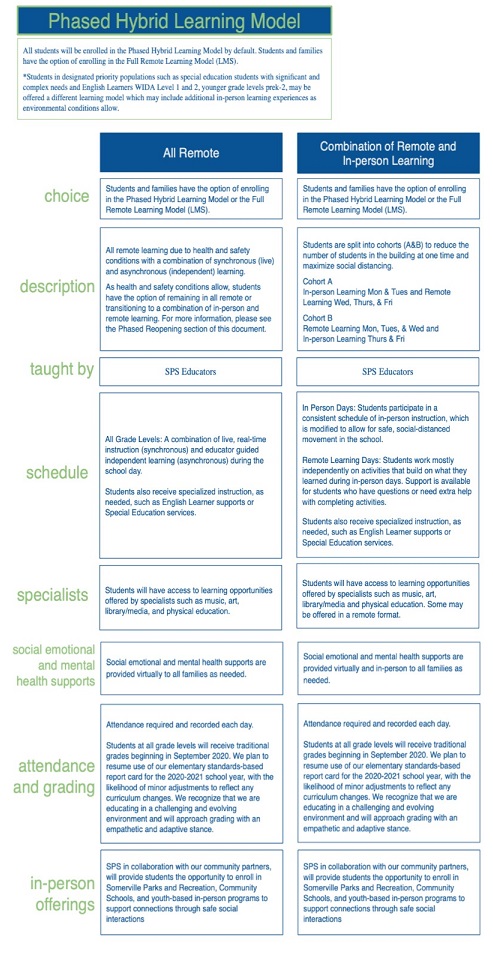
PK-8 Hybrid Learning Model - Phases 3 and 4
The PK-8 student population will be divided into two cohorts: Cohort A and Cohort B. Classes within each cohort will include 10-12 students. This allows reduction in the number of students physically in a building at any given time to facilitate 6-foot social distancing.
Students will rotate between a two day in-person and three day remote schedule. Students in Cohort A would receive full-day in-person instruction on Monday and Tuesday and engage in remote learning Wednesday, Thursday, and Friday. Students in Cohort B would engage in full-day remote learning Monday, Tuesday, and Wednesday and receive full-day in-person instruction on Thursday and Friday. All students learn remotely on Wednesdays.
Remote learning will include a combination of synchronous learning (live connections with teachers and peers where students are learning together at the same time) and asynchronous learning (independent learning opportunities where students may access and engage in learning and materials at differing times). Instruction will include core content areas such as English Language Arts (ELA), Mathematics, Social Studies, and Science, as well as specialists such as Music, Physical Education (PE), Library/Media, and Art. Academic supports for students receiving Special Education and English Language Learner services will continue.
In phases 3 and 4 of the phased hybrid model, access to in-person learning will be less than in previous traditional models of schooling. Acknowledging this reduction, in-person instruction will capitalize on learning activities and engagement best served by in-person learning. In-person learning will also be designed to prepare students to engage in independent work during the three days of remote learning.
Every Wednesday, PreK-8 students will be engaged in remote learning. “Remote Learning Wednesdays” will allow for a midweek thorough cleaning of school buildings. Wednesdays will also provide educators with opportunities to engage in common planning, develop weekly lesson plans, and communicate with families.
Special education students with significant and complex needs and English Learners WIDA Level 1 and 2 will be priority groups to resume full-time in-person learning to the greatest extent possible. Younger grade levels, preK-2, will also be given priority in the Phased Hybrid Model.
The table below serves as examples of the schedule in the Phased Hybrid Learning Model. They are subject to change based on changing circumstances and negotiations with the Somerville Teachers Association.
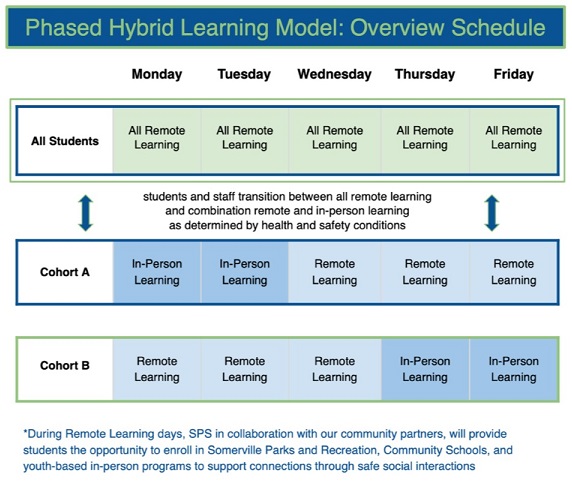
Somerville High School Phased Hybrid Learning Model
(edited for August 17 version - see Appendix A for a record of changes)
Adjusting the model of learning in a high school setting is a complex undertaking due to the variety of courses, services, and opportunities offered to students. In preparation for the 2020-21 school year, more than fifty percent of the educators at Somerville High School have been collaborating throughout the summer to plan for adjusted learning and engagement. Structures to maintain collaboration between educators will continue into the Fall to encourage teamwork, creativity, and added teacher support. This includes expanding grade level support teams and professional learning communities to all grade levels to provide time for building additional student supports and mentorship. As with any changes to working conditions and schedules, these changes need to be negotiated with the appropriate unions.
We recognize that high school teachers work with a large number of students. This means we will need to be creative in how we are forming space for community and relationship building. We also recognize that rigorous courses and rich learning experiences are an important and central part of the high school experience. We will adapt and be creative to ensure these experiences, although will look different, continue to be rich and valuable.
All Remote Learning
On August 12, staff and families were notified by the Mayor, Superintendent, and School Committee Chair of the decision for Somerville High School students to remain in the All Remote phase of our Phased Hybrid Learning Model until the opening of the new high school building.
From the correspondence: “After discussion on the preliminary evaluation from our consultant with our colleagues at Health and Human Services and the Department of Infrastructure and Asset Management, it is clear that it would not be possible to adequately retrofit the ventilation systems in the existing high school, portions of which date back to 1895, before the new high school is ready for occupancy. Similarly, the preliminary review also indicates that it will not be possible to adequately retrofit the portion of the Edgerly building currently being used to house our CTE programs. Therefore, we have reached the difficult decision that Somerville High School students will need to stay in the All Remote phase of our Phased Hybrid Learning Model until the new high school building opens. Barring any additional construction delays, the new high school is expected to be ready for occupancy in December and will have a fully modern ventilation system with enhanced air exchange that meets safety thresholds as well as more space for students to safely distance, both enabling a phased in-person return to SHS.”
Somerville High School staff will continue preparations for the transition to the new building and a time when students have the option to be phased back into a combination of remote and in-person learning. Design for instruction that includes in-person learning can be found below in the section titled “Combination Remote and In-Person Learning.”
SHS All Remote Learning
SHS is proposing a cohort model, Red Cohort and Blue Cohort, for the All Remote Learning mode. Grades 9 and 12 will comprise the Red Cohort. Grades 10 and 11 will be the Blue Cohort. Organizing students into cohorts during remote learning allows for a smoother transition when the opportunity for a return to in-person learning arises.
Students at SHS will engage in an alternating week schedule, “A week” and “B week.” Classes 1, 2, and 3 will be taught during A week. Classes 4, 5, and 6 will be taught during B week. The alternating week schedule will allow students to manage fewer classes at a time.
SHS students continue to have the option of enrolling in up to 7 classes. Class 7 will run during the first or last block of the schedule and will remain remote when instruction shifts to include in-person learning. Class 7 provides additional course options for students and increases the flexibility within the schedule. Students engage in class 7 for a shorter duration of time than classes 1 through 6, therefore class 7 may run everyday.
Attendance will be taken in all classes. Students will engage with SHS’s established curriculum which includes Advanced Placement and CTE courses. Classes will be taught synchronously for four days a week, Monday, Tuesday, Thursday, and Friday. Synchronous (live) class time may be used for a combination of direct instruction, group work, presentations, virtual field trips, small group instruction, and one-on-one conferences. Wednesdays are independent work days for students. Students may also meet with their mentor teachers, service providers and/or school counselors or Career and College Ready counselors. CTE and non-CTE students might participate in their school to work program. Students enrolled in class 7 may also have live class on Wednesdays.
Sample schedules are included below. As with any modifications to working conditions and schedules, shifts need to be negotiated with the appropriate unions prior to adoption.
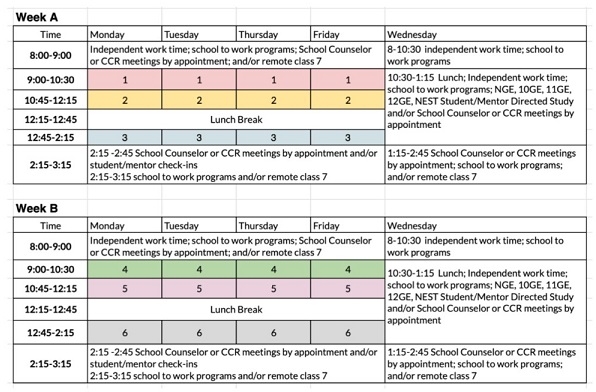
SHS staff is currently receiving training in remote instruction. Students should continue to expect a rich, engaging academic experience. Students will earn grades in all courses and will receive consistent feedback from their teachers on assignments. Students and families will have access to grades in Aspen.
As needed, students and families will meet with their teachers during office hours and/or scheduled appointments with counselors. Grade level teams will meet weekly to monitor student progress and plan a variety of supports to help students. House teams and SST teams will also meet weekly to support students. House Deans have been added to the staff to help with student outreach and support.
Staff will also receive training on integrating connection and community into daily lessons. Pending negotiations with appropriate unions, every student will be assigned a teacher mentor who will regularly check with students. Students will also have the opportunity to participate in virtual clubs. 9th graders will participate in a virtual orientation to ease their transition and welcome them to the SHS community.
Career and Technical Education (CTE)
While we understand that Career and Technical Education will be a different experience in a remote setting, we are putting plans into place to continue to make it a rich and valuable experience. Plans include:
- integrating multiple digital learning opportunities and platforms and in some cases, hands-on learning platforms to create a blended learning class experience.
- incorporating engaging video lessons that resemble real world experiences and CTE shop lessons.
- providing consistent feedback from shop instructors to parents and students on a bi-weekly basis to communicate progress and ensure that CTE requirements are completed.
- providing reliable supports.
- CTE counselors will be available daily for all CTE students and faculty.
- Students will have access to all other regular support services.
- A CTE Co-op Coordinator will support student placement in all co-ops and internships.
Additionally, we are proud and excited to showcase the CTE programs. Throughout the week, a Social Media Coordinator will highlight each program on the CTE Facebook and Twitter page.
Combination Remote and In-Person Learning
SHS is proposing a cohort model comprising a Red Cohort and Blue Cohort. Cohorts may be further divided by house as needed. Students would rotate between a two day in-person and three day remote schedule. The Red Cohort is composed of grades 9 and 12. Students in the Red Cohort receive full-day in-person instruction on Monday and Tuesday and engage in remote learning Wednesday, Thursday, and Friday. The Blue Cohort consists of grades 10 and 11. Students in the Blue Cohort would engage in full-day remote learning Monday, Tuesday, and Wednesday and receive full-day in-person instruction on Thursday and Friday. All students learn remotely on Wednesdays.
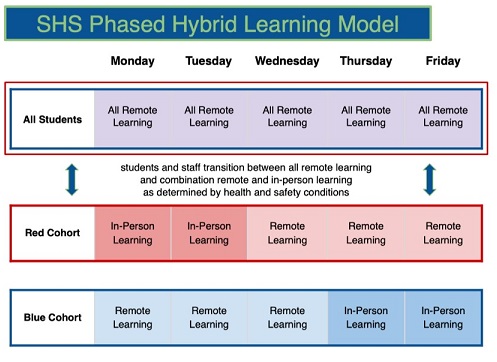
SHS is also proposing an alternating biweekly course schedule for in-person learning. During Week A, during in-person learning days, students attend courses 1, 2, and 3. During Week B, during in-person learning days, students focus on courses 4, 5, and 6. Students will also attend their remote class 7. This class is a flexible block of time and is scheduled based on staff and student needs. This schedule facilitates students focusing on fewer classes each week, allowing them to engage in depth with the coursework with their teachers and peers, and increase engagement and strengthen relationships within our learning community. On remote Wednesdays, students engage in a combination of courses, meet with their teacher mentor as needed, attend meetings with their service providers or school counselors, meet or attend workshops with the Career and College ready staff, and/or attend a school to work program (internship).
Sample student schedules are included below. As with any modifications to working conditions and schedules, shifts need to be negotiated with the appropriate unions prior to adoption.
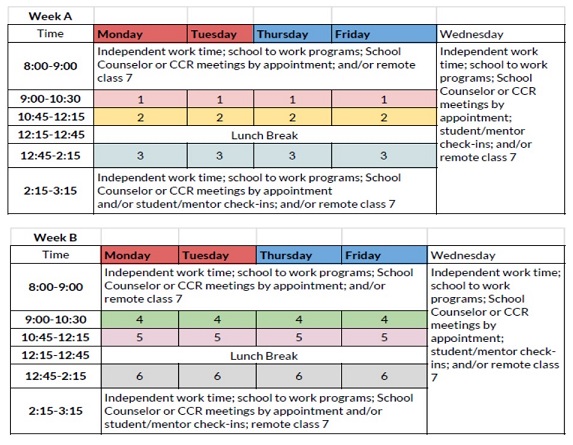
Next Wave / Full Circle Hybrid Learning Model
Next Wave / Full Circle is a tight-knit school community for students who have experienced academic setbacks and benefit from a personalized approach to learning. In order to meet the needs of our students we emphasize: Trusting Relationships, Authentic Learning Experiences, Growth Mindset and Student Voice and Choice, as essential components in our daily work. Last spring we saw how crucial relationship building was with respect to student engagement in a remote setting. For several years now, we have been focusing on student voice and choice as we develop meaningful core values to guide our decision making process during a school redesign (Resilience, Empathy, Responsibility, Collaboration, & Excellence). During the abrupt transition in March we quickly realized the importance of narrowing our academic focus, addressing equity, individualizing content, and lowering barriers for accessibility. We have decided to begin the school year by significantly narrowing the instructional focus, to better support both teachers and students as we engage in remote and hybrid learning environments while simultaneously transitioning to a completely project based model.
Students will engage in at least one cross-curricular, co-taught class which will align with two academic requirements. Two teachers will be assigned to each of these classes and will have the flexibility to keep synchronous (live) instruction in multiple small and manageable sections with time for specialized small group instruction. Each student will also be enrolled in a WIN (What I Need) block, focusing on addressing student needs and providing support. Students who have regressed in math or reading skills will work in small groups or experience one-on-one instruction to target essential skill areas. Students who have demonstrated competency in reading and math will have the opportunity to work on credit recovery classes, or independent research projects to continue on the path to on time graduation. In addition, counseling groups will occur twice a week continuing the crucial role our teacher/counselor model plays in building community and relationships. Counseling, specialists, and related services will occur in and outside of the classroom space in an asynchronous format (independent work).
We believe narrowing the instructional focus and providing relevant project based learning will have the biggest impact on student engagement and will provide us with a smooth transition to hybrid learning when the time comes. Students will rotate between a two day in-person and three day remote schedule. Students in Cohort A would receive in-person instruction on Monday and Tuesday and engage in remote learning Wednesday, Thursday, and Friday. Students in Cohort B would engage in full-day remote learning Monday, Tuesday, and Wednesday and receive in-person instruction on Thursday and Friday. All students learn remotely on Wednesdays. By rotating the cross-curricular classes at the quarter mark, students will still be able to complete all four core subjects in a semester and also have the opportunity to accelerate their learning within the WIN block.
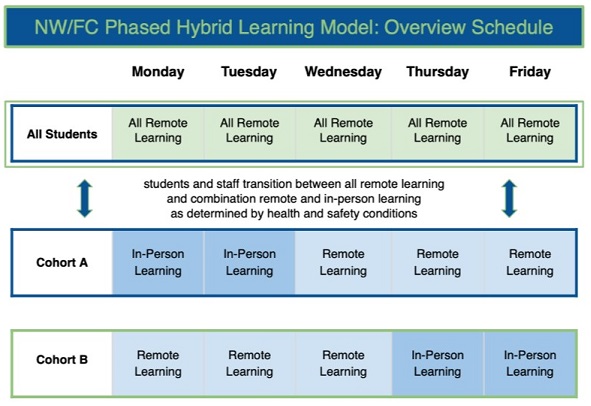
As with any modifications to working conditions and schedules, shifts need to be negotiated with the appropriate unions. Therefore, recognizing that certain specifics are still being discussed and negotiated, the table below provides an example of a possible student schedule:
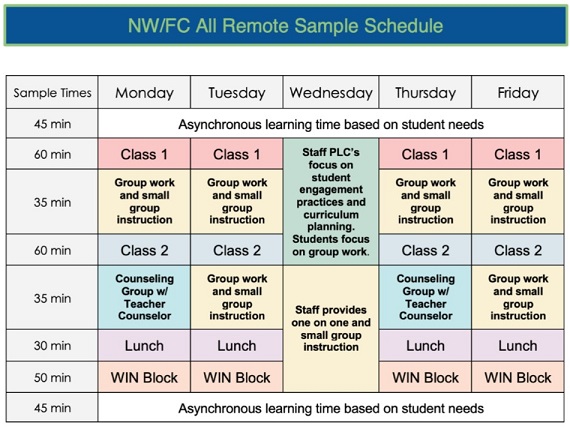
Continuing Our Redesign Work
Through support from the Barr Foundation, NWFC has been engaged in school redesign work over the last two two years as part of Barr’s Engage New England project. NWFC will continue this transformative work over the next two years, again with the generous support of the Barr Foundation through a 2-year $550,000 implementation grant.
Despite the abrupt arrival of a pandemic that disrupted learning as we knew it, the 2019-2020 school year was an outstanding year for the NWFC community. Students enrolled in pilot project based classes showed improved class attendance and engagement. We also saw an elevation of student discourse; students expressed excitement about their learning and the level and quality of student work produced during this pilot year was astounding.
The project based pilot experience at Full Circle through Transformative Learning Experiences (project based learning) has been deeply impactful. Two highlights include:
- Creativity, excitement, and ownership among staff. Teachers are excited about co-teaching, interdisciplinary learning, and project-based learning. Our designated pilot teachers brought levels of creativity, collaboration, and excitement to the work that were contagious around the whole building.
- Deeper engaged learning and higher levels of cognitive lift by students. The work students produced demonstrated that our students are capable of incredible levels of learning and output if we provide the opportunities and supports they need to take charge of their own learning.
Transformative Learning Experiences (Project Based Learning)
The design of a TLE/PBL consists of four core components, which are designed in a specific order and back-mapped from prioritized competencies.
During the spring closure due to Covid-19, teachers who were already co-teaching were seeing more successes with student engagement. They have also found that having a colleague to plan and learn different online platforms with was incredibly beneficial. These successes led us to start making plans for a full implementation of co-teaching/interdisciplinary project based courses to kick off the school year.
This is a complex time but we are continuing to move forward with the implementation of our design priorities. We have adopted a set of guiding principles that will help focus our decision making and planning during this time: Narrow the focus, Keep it concise, Lower the barriers, Address equity, Individualize. We will focus on: Community & Relationships, Competencies (Argue, Discern & Connect), Supporting teachers with planning & implementing projects, Effective feedback as students progress towards individual goals, Celebrations & Core Values.
